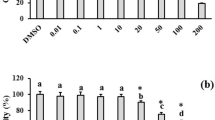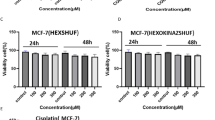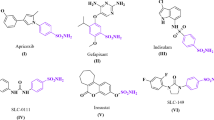Abstract
Aim:
Proteins with legume lectin domains are known to possess a wide range of biological functions. Here, the antitumor effects of two representative legume lectins, concanavalin A (ConA) and Sophora flavescens lectin (SFL), on human breast carcinoma cells were investigated in vitro and in vivo.
Methods:
Human breast carcinoma MCF-7 cells and human normal mammary epithelial MCF-10A cells were examined. Cell viability was detected using WST-1 and CCK-8 assays. Cell apoptosis was analyzed with Hoechst 33258 staining. Cell cycle was investigated using flow cytometry. The expression of relevant proteins was measured using Western blotting. Breast carcinoma MCF-7 bearing nude mice were used to study the antitumor effects in vivo. The mice were injected with ConA (40 mg/kg, ip) and SFL (55 mg/kg, ip) daily for 14 d.
Results:
ConA and SFL inhibited the growth of MCF-7 cells in dose- and time-dependent manners (IC50 values were 15 and 20 μg/mL, respectively). Both ConA and SFL induced apoptotic morphology in MCF-7 cells without affecting MCF-10A cells. ConA and SFL dose-dependently increased the sub-G1 proportion in MCF-7 cells, while SFL also triggered the G2/M phase cell cycle arrest. Both ConA and SFL dose-dependently increased the activities of caspase-3 and caspase-9 and release of cytochrome C from mitochondria into cytoplasm, up-regulated Bax and Bid, and down-regulated Bcl-2 and Bcl-XL in MCF-7 cells. ConA reduced NF-κB, ERK, and JNK levels, and increased p53 and p21 levels, while SFL caused similar changes in NF-κB, ERK, p53, and p21 levels, but did not affect JNK expression. Administration of ConA and SFL significantly decreased the subcutaneous tumor mass volume and weight in MCF-7 bearing nude mice.
Conclusion:
ConA and SFL exert anti-tumor actions against human breast carcinoma MCF-7 cells both in vitro and in vivo.
Similar content being viewed by others
Log in or create a free account to read this content
Gain free access to this article, as well as selected content from this journal and more on nature.com
or
References
Peumans WJ, Van-Damme EJ, Barre A, Rouge P . Classification of plant lectins in families of structurally and evolutionary related proteins. Adv Exp Med Biol 2001; 491: 27–54.
Van-Damme EJ, Nakamura-Tsuruta S, Smith DF, Ongenaert M, Winter HC, Rouge P, et al. Phylogenetic and specificity studies of two-domain GNA–related lectins: generation of multispecificity through domain duplication and divergent evolution. Biochem J 2007; 404: 51–61.
Li CY, Xu HL, Liu B, Bao JK . Concanavalin A, from an old protein to novel candidate anti-neoplastic drug. Curr Mol Pharmacol 2010; 3: 123–8.
Ouyang L, Shi Z, Zhao S, Wang FT, Zhou TT, Liu B, et al. Programmed cell death pathways in cancer: a review of apoptosis, autophagy and programmed necrosis. Cell Prolif 2012; 45: 487–98.
Li WW, Yu JY, Xu HL, Bao JK . Concanavalin A: a potential anti-neoplastic agent targeting apoptosis, autophagy and anti-angiogenesis for cancer therapeutics. Biochem Biophys Res Commun 2011; 414: 282–6.
Faheina-Martins GV, Da-Silveira AL, Cavalcanti BC, Ramos MV, Moraes MO, Pessoa C, et al. Antiproliferative effects of lectins from Canavalia ensiformis and Canavalia brasiliensis in human leukemia cell lines. Toxicol In Vitro 2012; 26: 1161–9.
Suen YK, Fung KP, Choy YM, Lee CY, Chan CW, Kong SK . Concanavalin A induced apoptosis in murine macrophage PU5-1.8 cells through clustering of mitochondria and release of cytochrome c. Apoptosis 2000; 5: 369–77.
Liu Z, Liu B, Zhang ZT, Zhou TT, Bian HJ, Min MW, et al. A mannose-binding lectin from Sophora flavescens induces apoptosis in HeLa cells. Phytomedicine 2008; 15: 867–75.
Liu B, Bian HJ, Bao JK . Plant lectins: potential antineoplastic drugs from bench to clinic. Cancer Lett 2010; 287: 1–12.
Shi Z, An N, Zhao S, Li X, Bao JK, Yue BS . In silico analysis of molecular mechanisms of legume lectin-induced apoptosis in cancer cells. Cell Prolif 2013; 46: 86–96.
Li CY, Luo P, Liu JJ, Wang EQ, Li WW, Ding ZH, et al. Recombinant expression of Polygonatum cyrtonema lectin with anti-viral, apoptosis-inducing activities and preliminary crystallization. Process Biochem 2011; 46: 533–42.
Li CY, Wang Y, Wang HL, Shi Z, An N, Liu YX, et al. Molecular mechanisms of Lycoris aurea agglutinin-induced apoptosis and G2/M cell cycle arrest in human lung adenocarcinoma A549 cells, both in vitro and in vivo. Cell Prolif 2013; 46: 272–82.
Liu B, Min MW, Bao JK . Induction of apoptosis by Concanavalin A and its molecular mechanisms in cancer cells. Autophagy 2009; 5: 432–3.
Amin AR, Paul RK, Thakur VS, Aqarwal ML . A novel role for p73 in the regulation of Akt-Foxo1a-Bim signaling and apoptosis induced by the plant lectin, Concanavalin A. Cancer Res 2007; 67: 5617–21.
Chen J, Liu B, Ji N, Zhou J, Bian HJ, Li CY, et al. A novel sialic acid-specific lectin from Phaseolus coccineus seeds with potent antineoplastic and antifungal activities. Phytomedicine 2009; 16: 352–60.
Lam SK, Nq TB . First report of a haemagglutinin-induced apoptotic pathway in breast cancer cells. Biosci Rep 2010; 30: 307–17.
Gartel AL, Tyner AL . The role of the cyclin-dependent kinase inhibitor p21 apoptosis. Mol Cancer Ther 2002; 1: 639–49.
Ghobrial IM, Witziq TE, Adjei AA . Targeting apoptosis pathways in cancer therapy. CA Cancer J Clin 2005; 55: 178–94.
Shi Z, Li CY, Zhao S, Yu Y, An N, Liu YX, et al. A systems biology analysis of autophagy in cancer therapy. Cancer Lett 2013; 337: 149–60.
Ryan KM, Ernst MK, Rice NR, Vousden KH . Role of NF-kappaB in p53-mediated programmed cell death. Nature 2000; 404: 892–7.
Li CY, Wang EQ, Cheng Y, Bao JK . Oridonin: An active diterpenoid targeting cell cycle arrest, apoptotic and autophagic pathways for cancer therapeutics. Int J Biochem Cell Biol 2011; 43: 701–4.
Gartel AL, Tyner AL . The role of the cyclin-dependent kinase inhibitor p21 in apoptosis. Mol Cancer Ther 2002; 1: 639–49.
Howe CL, Valletta JS, Rusnak AS, Mobley WC . NGF signaling from clathrin-coated vesicles: evidence that signaling endosomes serve as a platform for the Ras-MAPK pathway. Neuron 2001; 32: 801–14.
Acknowledgements
We are grateful to Dr Jian LI (Ohio University) and Wen-wen LI (University College London) for providing constructive suggestions. This work was supported in part by the National Natural Science Foundation of China (No 81173093, 30970643, J1103518, 81373311, and 31300674) and the Special Program for Youth Science and the Technology Innovative Research Group of Sichuan Province, China (No 2011JTD0026).
Author information
Authors and Affiliations
Corresponding author
Rights and permissions
About this article
Cite this article
Shi, Z., Chen, J., Li, Cy. et al. Antitumor effects of concanavalin A and Sophora flavescens lectin in vitro and in vivo. Acta Pharmacol Sin 35, 248–256 (2014). https://doi.org/10.1038/aps.2013.151
Received:
Accepted:
Published:
Issue date:
DOI: https://doi.org/10.1038/aps.2013.151
Keywords
This article is cited by
-
Coacervate-mediated novel pancreatic cancer drug Aleuria Aurantia lectin delivery for augmented anticancer therapy
Biomaterials Research (2022)
-
Concanavalin A as a promising lectin-based anti-cancer agent: the molecular mechanisms and therapeutic potential
Cell Communication and Signaling (2022)
-
Research advances and prospects of legume lectins
Journal of Biosciences (2021)
-
Ternary supramolecular quantum-dot network flocculation for selective lectin detection
Nano Research (2016)
-
Solanum tuberosum lectin inhibits Ehrlich ascites carcinoma cells growth by inducing apoptosis and G2/M cell cycle arrest
Tumor Biology (2016)



